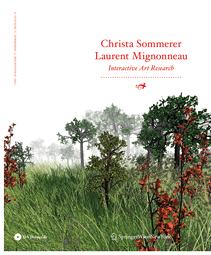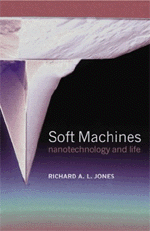Christa Sommerer & Laurent Mignonneau. Interactive Art Research (2009)
Filed under book | Tags: · algorithm, artificial life, evolution, interactivity, interface, internet, media art, nanotechnology

Christa Sommerer and Laurent Mignonneau are two of the most innovative and internationally renowned media artists and researchers. Their work has been called “epoch-making” (Toshiharu Itoh, NTT-ICC Museum, Tokyo) for developing natural and intuitive interfaces and for applying scientific principles such as artificial life, complexity, generative systems and nanotechnologies to their innovative interface design.
This monograph represents a comprehensive overview of Sommerer and Mignonneau’s art and research. In addition to providing detailed project descriptions of each interactive artwork, it includes essays and articles by highly recognized media scholars and theoreticians who bring the interactive artworks of Sommerer and Mignonneau in an art and media art history perspective.
Contributions from Roy Ascott, Anne Marie Duguet, Oliver Grau, Erkki Huhtamo, Machiko Kusahara, Hannes Leopoldseder, Christine Schopf and Peter Wiebel, among others
Editors: Gerfried Stocker, Christa Sommerer, Laurent Mignonneau
Publisher Springer, 2009
ISBN 3211990151, 9783211990155
Length 200 pages
N. Katherine Hayles (ed.): Nanoculture: Implications of the New Technoscience (2004)
Filed under book | Tags: · art, nanoscience, nanotechnology

“Nano” denotes a billionth; a nanometer is a billionth of a meter. New instrumentation and techniques have for the first time made possible materials research and engineering at this level, the scale of individual molecules and atoms.
Extraordinary visions of material abundance, unprecedented materials, and powerful engineering capabilities have marked the arrival of nanotechnology, as well as dystopian scenarios of self-replicating devices running amok and causing global catastrophe. Largely a future possibility rather than present actuality, nanotechnology has become a potent cultural signifier.
NanoCulture explores the ways in which nanotechnology interacts with, and itself becomes, a cultural construction. Topics include the co-construction of nanoscience and science fiction; the influence of risk assessment and nanotechnology on the shapes of narratives; intersections between nanoscience as a writing practice and experimental literature at the limits of fabrication; the Alice-in-Wonderland metaphor for nanotechnology; and the effects of mediation on nanotechnology and electronic literature.
NanoCulture is produced in collaboration with the nano art exhibit at the Los Angeles County Museum of Art (December 2003-September 2004), created by an interdisciplinary team led by media artist Victoria Vesna and nanoscientist James Gimzewski. NanoCulture is richly illustrated with images from the nano exhibit, which also provides the basis for an ethnographic analysis of collaborative process and an exploration of changing concepts of museum space.
The dynamic uniting these diverse perspectives is boundary crossing: between art, science, and literature; cultural imaginaries, scientific facts, and technological possibilities; actual. virtual, and hybrid spaces; the science of fictions and the fictions of science; and utopian dreams, material constraints, and dystopian nightmares.
The first book-length study focus on cultural implications of nanotechnology, NanoCulture breaks new ground in showing the importance of the new technoscience to contemporary culture and of culture to the development, interpretation, and future of this technoscience.
Publisher Intellect Books, 2004
ISBN 1841501131, 9781841501130
255 pages
PDF (updated on 2012-7-24)
Comment (0)Richard A. L. Jones: Soft Machines: Nanotechnology and Life (2008)
Filed under book | Tags: · nanotechnology

Enthusiasts look forward to a time when tiny machines reassemble matter and process information with unparalleled power and precision. But is their vision realistic? Where is the science heading? As nanotechnology (a new technology that many believe will transform society in the next on hundred years) rises higher in the news agenda and popular consciousness, there is a real need for a book which discusses clearly the science on which this technology will be based. While it is most easy to simply imagine these tiny machines as scaled-down versions of the macroscopic machines we are all familiar with, the way things behave on small scales is quite different to the way they behave on large scales. Engineering on the nanoscale will use very different principles to those we are used to in our everyday lives, and the materials used in nanotehnology will be soft and mutable, rather than hard and unyielding.
Soft Machines explains in a lively and very accessible manner why the nanoworld is so different to the macro-world which we are all familiar with. Why does nature engineer things in the way it does, and how can we learn to use these unfamiliar principles to create valuable new materials and artefacts which will have a profound effect on medicine, electronics, energy and the environment in the twenty-first century. With a firmer understanding of the likely relationship between nanotechnology and nature itself, we can gain a much clearer notion of what dangers this powerful technology may potentially pose, as well as come to realize that nanotechnology will have more in common with biology than with conventional engineering.
Publisher Oxford University Press, 2008
ISBN 0199226628, 9780199226627
Length 218 pages
Keywords and phrases
Brownian motion, nanometres, nanoworld, self-assembly, nanoscale, soft machines, photosynthesis, bacterium, atomic force microscope, quantum mechanics, electron beam lithography, water molecules, solar cells, micelles, light-emitting diode, integrated circuits, entropy, grey goo, scanning probe microscopes, hydrophobic
Book website
More info (publisher)
More info (google books)

